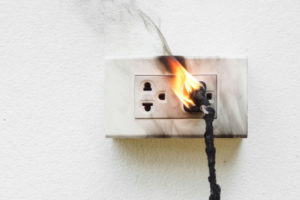 The wiring in your home has a lot to do with your home’s electrical safety and capability. A professional electrician knows how to not only ensure this but to also see that your home’s electrical wiring is up to standard.
The wiring in your home has a lot to do with your home’s electrical safety and capability. A professional electrician knows how to not only ensure this but to also see that your home’s electrical wiring is up to standard.
Cloth wiring is a subject that comes up more often than you would imagine because there’s hardly any shortage of old homes. Read on as we discuss what it means and more.
What is cloth wrapped electrical wiring and how to identify it?
Cloth covered wiring is exactly what it sounds like – wiring covered in a cloth material. This type of wiring was used mostly in homes built before 1960 and before plastic-covered wiring became the norm. At that time, cloth covered wiring was the standard. It was efficient and served the electrical needs of buildings. Some still do so today. This era also made use of the wiring system knob-and-tube. Both cloth covered wiring and the knob-and-tube system are outdated and not up to the standard of recent times. In many ways, both pose risks and homeowners with old homes are always encouraged to confirm the wiring they have.
You can identify cloth covered wiring easily at a glance. You can also lookout for a knob-and-tube wiring system that may indicate cloth-covered wiring. For even easier identification, here are some common brands of cloth covered wiring. You can inspect the wires to see the brand name;
- Essex
- Cablex
- Cres-flex
- Dutrax
- Kflex
- Narax
- Roflex/Romex
- Ammcoflex
- Hatflex
- Triangle PWC
- Southwire
The risks of cloth covered wiring.
- Prone to damage and wear and tear.
As expected with cloth material, cloth covered wiring can be chewed on by rodents and even damaged by insects. This can lead to exposure of the wire and electrical arcing, which is dangerous. Cloth wiring is also prone to wear and tear due to brittleness. The longer the wear and tear go on, the more the wires within are exposed. This then poses the risk of electrical fires due to electrical arcing.
- Insufficient insulation in modern times.
Proper insulation is vital to prevent heat from building up in the wires and creating a fire hazard. Cloth covered wiring is not effective at providing proper insulation. In modern homes especially, this lack of proper insulation can be dangerous.
- No grounding
Cloth covered wiring alongside the knob-and-tube system lack safety features like grounding. While this doesn’t make the wiring unsafe to use, it means there is no ground protection for your appliances against power surges.
With cloth wrapped electrical wiring being outdated, not up to recent codes and standard, and posing risks, it’s right to worry about them in your home. Some cloth covered wiring may be in good condition and reasonably safe, but only a professional electrician can determine that. If you live in an old home or suspect you have cloth covered wiring, contact a licensed electrician for an inspection.
The best solution to unsafe cloth covered wiring is rewiring the home to standard.




